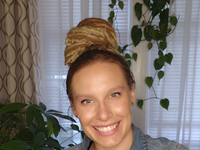Treatment for Individuals with Low Back Pain and Caesarean Scars
Treatment for Individuals with Low Back Pain and Caesarean Scars
BlogImage
by: Sonya Romanowski
Low back pain is one of the leading causes of disability worldwide, with caesarean (c-section) scar tissue often overlooked as a potential source of pain. Addressing scar tissue and massage therapy can be a beneficial form of treatment for individuals coping with persistent low back pain. Let's take a close look at how working with the c-section scar tissue in a massage therapy treatment and providing home care techniques specifically works for individuals dealing with low back pain and caesarean scars. This article will discuss the history of c-section surgeries, and the outcomes and anatomical connections that could result in low back pain. I will also cover how to truly appreciate and understand the formation of scar tissue and how the techniques I will discuss further in my seminar at the RMTAO Conference on June 10th in Toronto can be applied to any scar on the body. Lastly, you can learn about scar tissue manual therapy techniques and home exercise programming you can give to your patients.
The C-section is an incisional surgical procedure that has been practiced for centuries. C-sections represent a quarter of all births in Canada making it the most common hospital based surgery. While the procedure is generally safe, there are still risks involved, including scarring. Caesarean scars can cause discomfort and even lead to complications in future pregnancies. Up to 40% of individuals have reported persistence of low back pain even 6 months or longer post-surgical delivery. Over the past 25 years, the rate of C-section surgery has steadily increased, and it is important for healthcare providers to understand scar tissue formation to properly manage these scars to ensure the best possible outcomes for their patients.
Scar tissue is a natural part of the body's healing process. When there is tissue damage, the body sends signals to repair the affected area. Except for very minor lesions, every wound (e.g., post injury, disease, or surgery) results in some degree of scarring. Scar tissue is composed of the same protein (collagen) as the tissue that it replaces, but the fiber composition of the protein is different; instead of a random basketweave formation of the collagen fibers found in normal tissue, in fibrosis the collagen cross-links and forms a pronounced alignment in a single direction. This collagen scar tissue alignment is usually of inferior functional quality to the normal collagen randomized alignment. As a result, new cells and tissue form but they are not identical to the original tissue. Scar tissue can be thicker, harder, and less flexible than healthy tissue. This can lead to scar tissue adhering to various fascial layers which can decrease musculoskeletal mobility resulting in joint stiffness and pain. In some cases, scar tissue can even interfere with the function of organs, arteries, veins, lymph, and nerves. It is no surprise that there can be possible links to low back pain with individuals who have C-section scars.
Low back pain is a common issue that affects many individuals, and research shows that there is a correlation between low back pain and C-sections. The abdominal muscles play a crucial role in anatomy of the lower back, and when these muscles and fascia are cut and weakened due to a C-section surgery, it can lead to increased stress on the lower back. The C-section scar adherence to the uterus can play a factor in low back physiology due to the uterus’ ligamentous attachments to the iliac and sacral bones. When the mobility of the uterus is affected, this can lead to a reduction in sacroiliac joint and lumbosacral movement. There has been evidence to suggest that the epidural administered into the spinal can be another source of low back pain post-delivery. This is where the benefits of scar tissue treatment with massage therapy come into play.
Scar tissue is formed as a natural part of the healing process after an injury, but if not assessed and addressed for fascial adherences, it can cause chronic pain and stiffness. By using specific massage techniques, therapists are able to increase scar tissue mobility and blood flow and promote healthy musculoskeletal movement patterns. This allows the body to adapt and move more effectively, resulting in reduced pain and improved mobility. It is also important to consider that what the patient does on a daily basis will affect their pain levels in and out of treatment. Providing appropriate home care exercises is crucial to their recovery and success.
Individuals with low back pain related to a history of caesarian scars can benefit from scar tissue treatment and massage therapy. At my seminar during the RMTAO Understanding Pain Conference on June 10 in Toronto, you will gain the knowledge and skills needed to treat scar tissue effectively and bring relief to your patients. This includes learning about the history, surgical procedure, and rate of caesarean scars as well as understanding how scar tissue is made and its impact on the body. You'll also learn ways to address low back pain and its connection to C-sections through massage therapy treatment of scar tissue, as well as appropriate home care, specifically patient oriented myofascial scar techniques for self treatment.
Examine the prevalence of low back pain linked with caesarean section scars across all demographics by signing up for my session called Treatment for Individuals with Low Back Pain and Caesarean Scars, at the RMTAO conference next month! With this session, you’ll be well on your way to expanding your knowledge base and making a real difference in the lives of your patients. Early bird rates end next week—sign up now!


